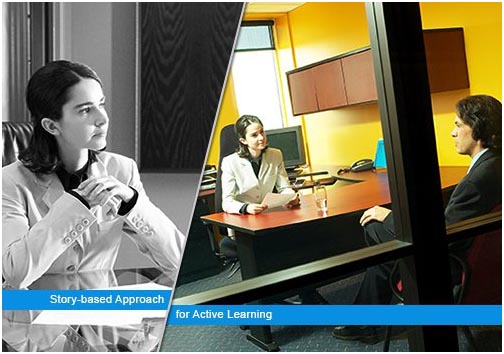
The aim of training is to improve employee performance. This goal is met when training is short, focused, and easy to assimilate and apply. In this article, I show how microlearning can transform your recorded VILT sessions into short bites.
Why Should You Transform Your Recorded VILT Sessions into Microlearning Modules?
Virtual Instructor-Led Training (VILT) comes with some legacy “learning baggage” (including lengthy recordings) that may not be appropriate to address all of remote learning challenges today.
Microlearning helps overcome many of those challenges and offers greater learner engagement and better knowledge transference.
- Both learners and L&D teams benefit from microlearning modules, which are particularly useful when offered in the flow of work, to build a habit of learning and for continuous learning.
- Unlike VILT, micro-content is short and focused, and learners can access them on the go. It is ideal for creating just-in-time learning aids/Performance Support Tools (PSTs) for a moment-of-need delivery and can be integrated effectively into the learners’ workflow.
- Trainers benefit from it because it addresses the “Forgetting Curve” and “Retention Curve” challenges. L&D teams also find that microlearning creates much more sticky learning than VILT, which leads to higher (compared to VILT) training completion rates.
How Can You Transform Your VILT Sessions into Microlearning Modules?
Many L&D teams have a lot of digital learning resources, as part of their corporate VILT strategies, that they have historically invested heavily to create. Pivoting to a microlearning strategy doesn’t necessarily mean discarding these investments.
In fact, here are 6 strategies to consider when transforming your VILT sessions into microlearning modules:
- Use your existing VILT content as a base and redesign them to supplement your macrolearning courses (for example, “Quick facts…”; or “More exercises…”; or “Explore this topic further…”).
- Carve out content from your current VILT modules and transform them to support the flow of work. To build just-in-time learning resources, create 3-to-5-minute microlearning modules so learners may consume them on the devices of their choice, anytime, anyplace, and as needed to offset the “Forgetting Curve.”
- Add micro-assessments, in the form of short quizzes and scenario-driven exercises based on your VILT sessions, to help learning reinforcement and retention.
- Create learner-centric, outcome-specific, targeted sub-content, from existing VILT sessions, to use as PSTs that address specific training objectives (for example, “How to…”; “Step-by-step…”; “Quick Start Resource…”).
- To encourage continuous learning, produce a library of microlearning nuggets, such as reference materials and tips and tricks, from your current ILT/VILT content and make it easily accessible/shareable so learners have a point-of-need/moment-of-need resource (without having to review the entire course).
- Summarize and condense existing ILT/VILT content into pre-course teasers as well as end-of-module review and reinforcement material.
What Are Some of the Options You Should Consider While Transforming Your VILT Sessions into Microlearning Modules?
Transforming and repackaging ILT and VILT sessions into engaging and effective microlearning modules isn’t a matter of simply reducing or summarizing content. The approach you choose depends on the business objective you’re trying to address.
Here are 3 options to consider when creating microlearning content from virtual classroom sessions:
- Maintain the status quo: In the case of mandated but lengthy eLearning courses (for example, a 45-minute Intro on Federal Health & Safety Protocols), there may be little L&D teams can do to alter the content. However, 3-to-5-minute microlearning sub-content may be added to offer learning retention (of the key elements from the 45-minute course), as well as adding shorter videos or PDFs that act as PSTs on the job.
- Augment existing courses: Micro-quizzes, assessments, and exercises may be used to augment the 45-minute Federal Health & Safety Protocols course to focus learner attention and discussion around specific aspects of the broader topic. These microlearning modules will also serve to change learner behavior once they complete the lengthy VILT sessions.
- Transform existing courses: Lengthy VILT courses result in cognitive overload. If the 45-minute course isn’t mandated for “as is” delivery, L&D teams may transform the content into shorter, but focused, 3-to-5-minute micro-videos dealing with specific health and safety issues like fire hazards, slippery surfaces, etc.
What Best Practices Should You Adopt While Transforming Your Existing VILT Sessions into Microlearning Modules?
Here are 4 best practices to help you transform your existing VILT training sessions into microlearning modules:
- Change focus: VILT content typically has a broad focus (for example, “Building Impactful Websites”). Best practices for creating impactful microlearning modules requires narrower-focused content. For instance, while maintaining focus on the big picture “Building Impactful Websites” session, you might narrowly refocus on “Creating Marketing Websites” or “Building a Customer Support Resources Website.”
- Chunk-up content logically: To be impactful and engaging for in-the-flow learning, best practice dictates that each microlearning module shouldn’t exceed 3 to 5 minutes in length (not exceeding 7 mins). Arbitrary truncation of existing recorded VILT sessions just won’t cut it. When refocusing your content (best practice #1 above), therefore, make sure you don’t exceed the 3-to-5-minute length for each micro-topic.
- Condense themes: Chunking focuses on physical length while condensing aims at reducing the number of themes contained in a microlearning module. For instance, it’s no good to transform a 30-minute VILT session into two logically chunked-up micro-sessions – one 25 minutes in length, the other 5 minutes long. One best practice, to encourage the habit of frequent learning, is to reduce the number of themes (topics, subjects) discussed in each microlearning module. Instead of covering everything important in a single micro-module, you could re-engineer the “Creating Marketing Websites” session to deal with just two themes: “Writing Powerful Landing Pages” and “Creating Powerful Headlines.”
- Change…but don’t pivot: Reducing and refocusing your VILT content shouldn’t lead to a transformational pivot away from the original session objectives. Best practices dictate that you resist the temptation to add new content or bring in new topics or subjects.
I hope this article provides the requisite insights that will help you transform your recorded VILT sessions into engaging microlearning modules.
Meanwhile, if you have any specific queries, do contact me or leave a comment below.
Read More
- Webinar: How To Leverage Microlearning To Build Employee Learning Habits And Drive Continuous Learning
- How to Blend Microlearning and Macrolearning to Deliver a Higher Impact Workplace Training
- 8 Effective Approaches to Gamify Your VILT Programs and Drive Remote Learner Engagement
- How to use Game-based Learning to Drive Learner Engagement and Motivation
- How to Identify the Right Training KPIs for Your Learning and Development Programs



